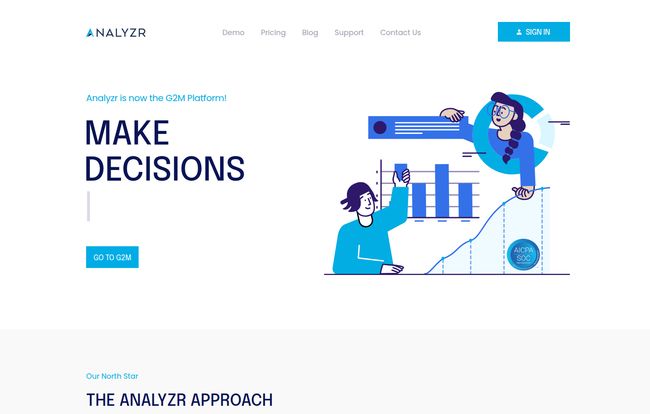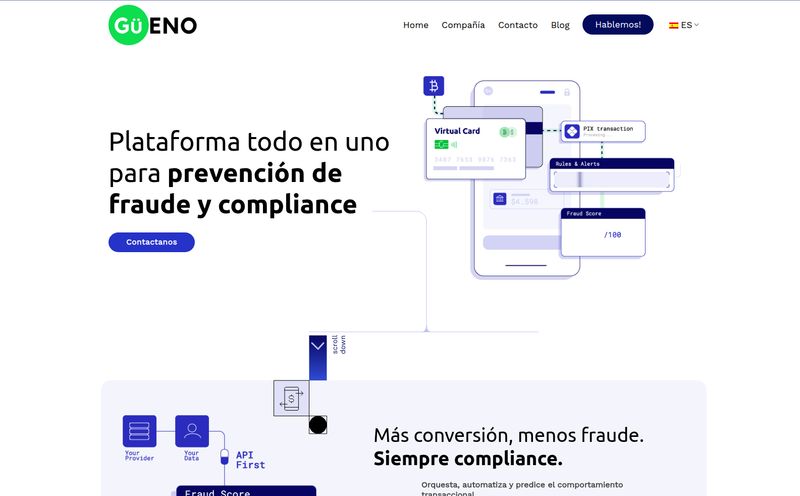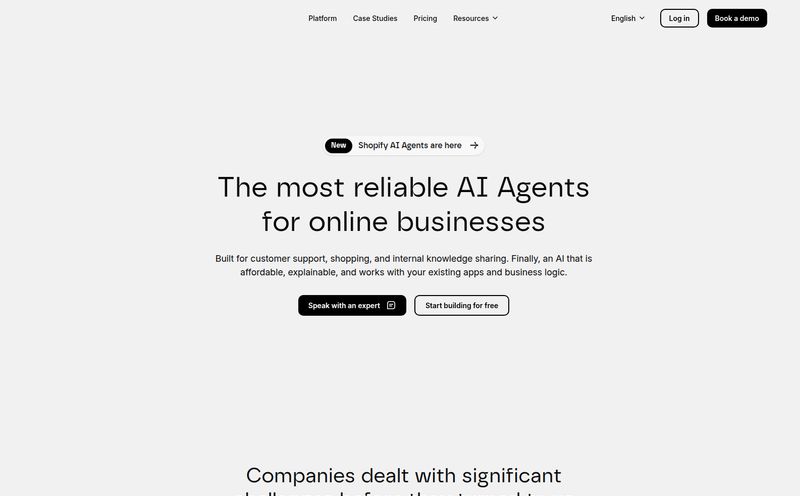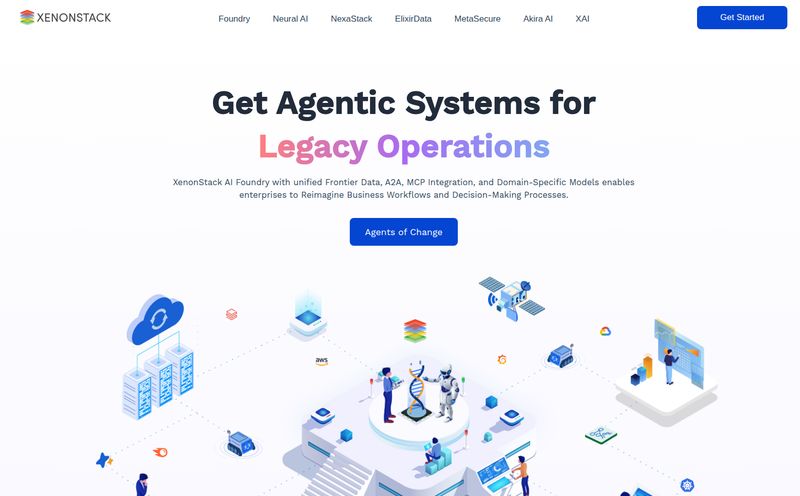We’re all sitting on mountains of data. Gigabytes of it. Terabytes, even. It’s in our CRMs, our analytics platforms, our spreadsheets… oh god, the spreadsheets. We're told this data is the new oil, the key to everything. But most days, it feels more like a messy garage you're afraid to open.
We’ve all been in that marketing meeting. The one where someone asks, “So, who are our most valuable customers, really?” and everyone sort of looks at their shoes. Or the sales call where you’re trying to decide which leads to focus on this quarter, and the decision is based more on caffeine and gut instinct than actual data. I've been there. It's frustrating.
The promise of machine learning and predictive analytics has always been dangled in front of us as the solution. But it always came with a catch: you needed a team of data scientists with PhDs, a budget the size of a small country, and the patience of a saint. Until now, maybe.
I’ve been keeping my eye on the rise of “no-code” platforms, and a tool called Analyzr recently caught my attention. It claims to be a no-code predictive analytics platform built specifically for B2B sales and marketing. A big claim. So, I dug in to see if it’s the real deal or just another piece of shiny, expensive shelf-ware.
What is Analyzr, Really? (Beyond the Buzzwords)
Forget the jargon for a moment. At its heart, Analyzr is a tool that lets regular business people—like marketers, sales ops pros, and business analysts—do incredibly smart things with their data without writing a single line of code.
Think of it like this: you have all the ingredients (your data from HubSpot, Snowflake, etc.), but you’re not a master chef (a data scientist). Analyzr is like one of those high-tech smart ovens that knows exactly how to cook the ingredients to perfection. You just select what you want to make—say, a list of customers likely to churn—and it handles the complex parts for you, serving up a result that you can actually use.
It’s designed to bridge the gap between having data and having answers. Real, actionable answers that can help you make more money, keep more customers, and stop guessing so much.

Visit Analyzr
The Analyzr Workflow: From Messy Data to Clear Decisions
The part that always trips people up with ML is the process. It sounds intimidating. Analyzr tries to boil it down to a few straightforward steps, which I appreciate. There's no command line, no talk of Python libraries, just a clean interface.
Step 1: Connect Your Data Sources
First things first, you have to feed the machine. Analyzr seems to get that our data is scattered everywhere. It's designed to connect to the big players you’re likely already using—I saw logos for Microsoft Azure, Snowflake, HubSpot, and Alteryx on their site. This is a good sign. It shows they understand the modern data stack. You’re not expected to manually export CSVs all day, which is a relief.
Step 2: Train Your Model (Don't Panic, It's Easy)
This is the part that usually requires a pocket protector and a deep understanding of statistics. With Analyzr, it’s more about defining your goal. You connect your data, and then you tell it what you’re trying to figure out. The platform handles the heavy lifting of processing the data and preparing it for analysis.
Step 3: Pick Your Variables and Algorithm
Okay, this is where a little bit of thought is required, but it's not as scary as it sounds. You’re essentially just telling the tool which pieces of your data are important for the question you’re asking. For example, if you want to predict customer lifetime value, you'd probably select variables like 'first purchase amount,' 'products purchased,' and 'time since last order.' The platform then suggests algorithms to run the analysis. It’s a guided process, not a final exam.
Step 4: Get Actionable Insights
This is the payoff. Instead of a mess of code and statistical charts that only a quant would love, Analyzr delivers digestible results. Think clean dashboards, propensity scores (e.g., “this lead has an 85% chance to convert”), and customer segments that you can push back into your native systems. The whole point is to make the insights accessible and, more importantly, usable by your sales and marketing teams immediately.
Practical Ways You'll Actually Use Analyzr
Okay, theory is nice. But how does this help you hit your quarterly numbers? Based on what I've seen, here are some of the most powerful applications for a B2B team.
- Propensity Scoring: This is the big one. It’s about predicting the future. You can build a model to score all your leads on their likelihood to convert, or score your existing customers on their likelihood to churn or buy another product. This is how you focus your sales team's energy where it counts most, instead of having them smile-and-dial through a giant list.
- Clustering: Ever feel like you have different 'types' of customers but can't quite define them? Clustering automatically groups similar customers together based on their behavior. You might uncover a hidden segment of “high-growth potential” clients or an “at-risk” group that needs some extra attention. It’s like a super-powered market segmentation.
- Regression Analysis: If you want to predict a number instead of a yes/no outcome, this is your tool. Use it to forecast a customer's potential lifetime value (LTV) or predict the likely deal size for a new prospect. Super useful for financial planning and resource allocation.
- Smarter A/B Testing: Instead of just seeing which landing page won, you can analyze the results to see which page won for specific customer segments. Maybe Page A is better for enterprise clients, while Page B resonates more with SMBs. That's a level of nuance most platforms don’t offer.
Let's Talk Money: The Analyzr Pricing Breakdown
Ah, the all-important question. Nothing kills the excitement for a new tool faster than a terrifying price tag. Analyzr has a tiered structure that’s actually pretty logical. I was happy to see a free plan, which is always a good sign.
| Plan | Price | Key Features | Best For |
|---|---|---|---|
| Starter | Free | 1 user, 10 models, 10k rows limit, SOC 2 compliant | Individuals and students just getting started or testing the waters. |
| Premium | $499/mo | Up to 5 users, Unlimited models & datasets, 200k rows limit, REST API access | Small teams of business analysts or marketing departments ready to get serious. |
| Enterprise | Let's Talk | Unlimited everything, dedicated resources, SSO, flexible deployment, priority support | Large organizations needing enterprise-grade security, scale, and support. |
The Starter plan is genuinely useful for a single user to kick the tires and see if the workflow clicks. The Premium plan feels like the sweet spot for most mid-sized B2B companies. And the Enterprise plan is the classic “if you have to ask, you can afford it” tier, but it comes with the serious security (SAML/SSO) and support that big companies require.
The Potential Downsides: A Realistic Look
No tool is perfect, and from my experience, it’s best to go in with eyes wide open. Here are a few things to keep in mind:
- Data Is Still King: This is a classic GIGO (Garbage In, Garbage Out) situation. Analyzr can do amazing things, but only if the data you feed it is relatively clean and meaningful. It’s not a magic wand that can fix a fundamentally broken data collection strategy. You still need to do the hard work of gathering good data.
- The “Algorithm” Step: While they’ve simplified it, the step where you pick variables and an algorithm could still be a bit daunting for a complete novice. It requires some business context and a basic understanding of what you’re trying to achieve. This isn’t a one-click-and-done solution, it's a no-code workbench.
- Opaque Enterprise Pricing: It's standard practice, but the “Contact Sales” for the Enterprise plan always makes me sigh a little. It’s hard to budget without a ballpark number, but that’s the game for top-tier software.
My Final Take: Is Analyzr Worth Your Time?
After looking everything over, I'm genuinely optimistic about Analyzr. For years, the power of predictive modeling has been locked away in an ivory tower, accessible only to those who speak the language of code.
Analyzr feels like a serious attempt to democratize it for B2B teams. It’s not trying to replace data scientists; it’s trying to empower the people on the front lines—the marketers and sales pros who know the customers best—to use data in a more sophisticated way. It lowers the barrier to entry from “learn Python” to “understand your business goals.”
If your team is data-rich but insight-poor, and you feel like you’re constantly making decisions on gut feel alone, then giving the Analyzr free plan a spin seems like a no-brainer. It might just be the tool that finally helps you find the hidden patterns in your data and turn that messy garage into a high-performance engine for your business.
Frequently Asked Questions (FAQ)
- 1. Do I need to be a data scientist to use Analyzr?
- Absolutely not. That's the whole point. It's designed for business users, marketers, and sales operations professionals. You need to understand your business and your data, but you don't need to know how to code or have a background in statistics.
- 2. What kind of data sources can I connect to Analyzr?
- Analyzr is built to integrate with modern data stacks. The website highlights partnerships with major platforms like HubSpot, Snowflake, Microsoft Azure, and Alteryx, suggesting a focus on connecting to CRMs, data warehouses, and business intelligence tools where B2B data typically lives.
- 3. Is Analyzr secure for our sensitive customer data?
- Security seems to be a major focus. They mention a "zero-trust approach" and are SOC 2 Type 2 compliant, which is a key industry standard for data security. The Enterprise plan also offers dedicated single-tenant deployment and SSO integration, which are critical for large companies with strict security requirements.
- 4. What’s the main difference between the free Starter and paid Premium plan?
- The biggest differences are scale and collaboration. The Starter plan is for one person with limits on models and data rows (10k). The Premium plan is for a small team (up to 5 users), removes limits on models, massively increases the data row limit to 200k, and adds key features like a shared workspace and REST API access.
- 5. Can Analyzr predict which of my leads will become customers?
- Yes, that's a core use case called "propensity scoring." You can train a model using data from your past successful and unsuccessful leads to predict the likelihood of new leads converting. This helps your sales team prioritize their efforts effectively.



